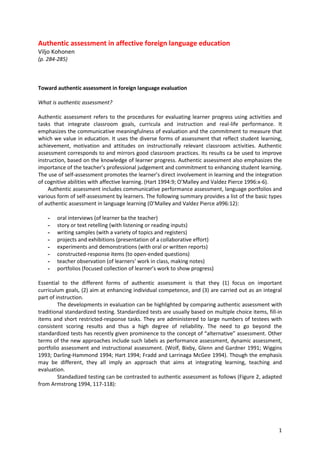
Authentic Assessment in Foreign Language Education
- 1. 1 Authentic assessment in affective foreign language education Viljo Kohonen (p. 284-285) Toward authentic assessment in foreign language evaluation What is authentic assessment? Authentic assessment refers to the procedures for evaluating learner progress using activities and tasks that integrate classroom goals, curricula and instruction and real-life performance. It emphasizes the communicative meaningfulness of evaluation and the commitment to measure that which we value in education. It uses the diverse forms of assessment that reflect student learning, achievement, motivation and attitudes on instructionally relevant classroom activities. Authentic assessment corresponds to and mirrors good classroom practices. Its results ca be used to improve instruction, based on the knowledge of learner progress. Authentic assessment also emphasizes the importance of the teacher’s professional judgement and commitment to enhancing student learning. The use of self-assessment promotes the learner’s direct involvement in learning and the integration of cognitive abilities with affective learning. (Hart 1994:9; O’Malley and Valdez Pierce 1996:x-6). Authentic assessment includes communicative performance assessment, language portfolios and various form of self-assessment by learners. The following summary provides a list of the basic types of authentic assessment in language learning (O’Malley and Valdez Pierce a996:12): - oral interviews (of learner ba the teacher) - story or text retelling (with listening or reading inputs) - writing samples (with a variety of topics and registers) - projects and exhibitions (presentation of a collaborative effort) - experiments and demonstrations (with oral or written reports) - constructed-response items (to open-ended questions) - teacher observation (of learners’ work in class, making notes) - portfolios (focused collection of learner’s work to show progress) Essential to the different forms of authentic assessment is that they (1) focus on important curriculum goals, (2) aim at enhancing individual competence, and (3) are carried out as an integral part of instruction. The developments in evaluation can be highlighted by comparing authentic assessment with traditional standardized testing. Standardized tests are usually based on multiple choice items, fill-in items and short restricted-response tasks. They are administered to large numbers of testees with consistent scoring results and thus a high degree of reliability. The need to go beyond the standardized tests has recently given prominence to the concept of “alternative” assessment. Other terms of the new approaches include such labels as performance assessment, dynamic assessment, portfolio assessment and instructional assessment. (Wolf, Bixby, Glenn and Gardner 1991; Wiggins 1993; Darling-Hammond 1994; Hart 1994; Fradd and Larrinaga McGee 1994). Though the emphasis may be different, they all imply an approach that aims at integrating learning, teaching and evaluation. Standadized testing can be contrasted to authentic assessment as follows (Figure 2, adapted from Armstrong 1994, 117-118):
- 2. 2 Standardized testing Authentic assessment 1 Testing and instruction are regarded as separate activities Assessment is an integral part of instruction 2 Students are treated in a uniform way Each learner is treated as a unique person 3 Decisions are based on single sets of data (test scores) Provides multiple sources of data, a more informative view 4 Emphasis on weaknesses/failures: what students cannot do Emphasis on strengths/progress: what learners can do 5 One-shot exams Ongoing assessment 6 Cultural/socio-economic status bias More culture-fair 7 Focus on one “right answer” Possibility of several perspectives 8 Judgement without suggestions for improvement Useful information for improving/guiding learning 9 Pressures teachers to narrow teaching what is tested Allows teacher to develop meaningful curricula 10 Focus on lower-order knowledge and skills Emphasis on higher-order learning outcomes and thinking skills 11 Forbids sudents to interact; promotes comparisons between students (norm- referencing) Encourages collaborative learning; compares learners to their own past performances and the aims 12 Extrinsic learning for a grade Intrinsic learning for its own sake Comparison of standardized testing and authentic assessment